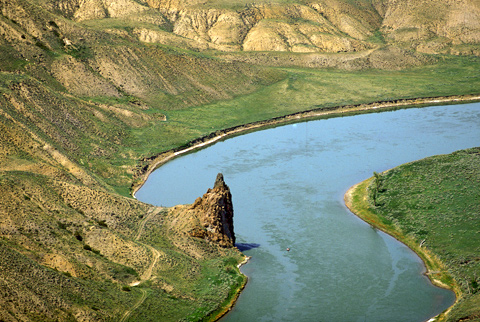Citadel Rock
25 miles northeast of Geraldine, Montana
(view southwest, upstream)
© 2000 Airphoto—Jim Wark.
To gain a sense of the scale of the land and river in this scene, find the speck in the water directly to the right of the rock’s shadow, about one-quarter of the way across the river. That speck is two people in separate kayaks, side-by-side.
Clark remarked on this “high Steep black rock riseing from the waters edge” as they passed it on 31 May 1805, but he did not give it a name. Citadel Rock, so called during the steamboat era for its fortress-like presence, was an igneous intrusion into a layer of sandstone that had washed away, leaving the harder basalt pillar standing.
The ill-fated white pirogue logged another narrow escape that day when the tow rope broke and the boat struck a rock, nearly turning over. “I fear,” Lewis lamented, “her evil gennii will play so many pranks with her that she will go to the bottomm some of those days.” Against expectations, it would survive to haul the explorers all the way back to St. Louis from the Great Falls of the Missouri, where it would spend the winter hidden in the willows.
That tow rope was their last remaining hemp rope, “and that on which we most depended.” Considering the importance of rope to any expedition in those days, whether on water or on land, it is surprising that within scarcely more than a month after leaving Camp Dubois on 14 May 1804, they had had to stop and make rope out of animal skins. Fortunately, somewhere between Philadelphia and St. Louis, Lewis had bought the equipment necessary for a rope walk (see Making Rope).
On the return trip in the summer of 1806, Lewis and his party raced through “that very interesting part of the Missouri where the natural walls appear” on 30 July 1806. They were to have met Clark and his contingent at the mouth of the Yellowstone on 1 August, but at the end of this day they still had four hundred miles to go. Averaging sixty miles per day, they made it to the meeting point by 7 August 1806 and caught up with Clark on 12 August 1806.
From Discovering Lewis & Clark from the Air
Photography by Jim Wark
Text by Joseph Mussulman
Reproduced by permission of Mountain Press
Experience the Lewis and Clark Trail
The Lewis and Clark Trail Experience—our sister site at lewisandclark.travel—connects the world to people and places on the Lewis and Clark Trail.
Discover More
- The Lewis and Clark Expedition: Day by Day by Gary E. Moulton (University of Nebraska Press, 2018). The story in prose, 14 May 1804–23 September 1806.
- The Lewis and Clark Journals: An American Epic of Discovery (abridged) by Gary E. Moulton (University of Nebraska Press, 2003). Selected journal excerpts, 14 May 1804–23 September 1806.
- The Lewis and Clark Journals. by Gary E. Moulton (University of Nebraska Press, 1983–2001). The complete story in 13 volumes.


